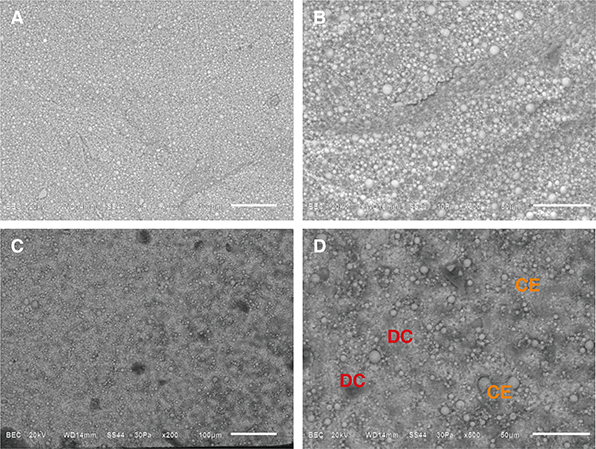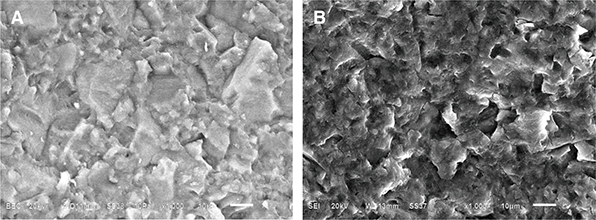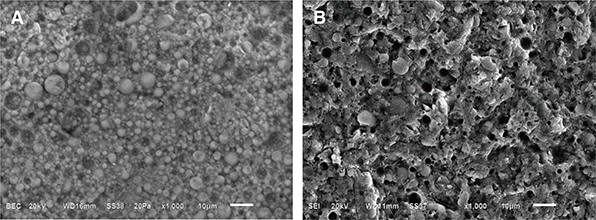J Adv Prosthodont.
2017 Feb;9(1):38-44. 10.4047/jap.2017.9.1.38.
Microtensile bond strength of repaired indirect resin composite
- Affiliations
-
- 1Prosthodontics Department, Faculty of Dentistry, Mahidol University, Bangkok, Thailand. porntida.sup@mahidol.ac.th
- KMID: 2368210
- DOI: http://doi.org/10.4047/jap.2017.9.1.38
Abstract
- PURPOSE
The objective of this study was to investigate the effect of surface treatments on microtensile bond strengths (MTBSs) of two types of indirect resin composites bonded to a conventional direct resin composite.
MATERIALS AND METHODS
Indirect resin composite blocks of Ceramage and SR Nexco were prepared in a plastic mold having a dimension of 10 × 10 × 4 mm. These composite blocks were divided into three groups according to their surface treatments: Group1: Sandblast (SB); Group2: Sandblast and ultrasonically clean (SB+UL); Group3: Sandblast plus silane (SB+SI). After bonding with direct resin composite, indirect-direct resin composite blocks were kept in distilled water for 24 hours at 37℃ and cut into microbars with the dimension of 1 × 1 × 8 mm. Microbar specimens (n = 40 per group) were loaded using a universal testing machine. Failure modes and compositions were evaluated by SEM. The statistical analyses of MTBS were performed by two-way ANOVA and Dunnett's test at α = .05.
RESULTS
Surface treatments and brands had effects on the MTBS without an interaction between these two factors. For SR Nexco, the MTBSs of SB and SB+SI group were significantly higher than that of SB+UL. For Ceramage, the MTBSs of SB and SB+SI were significantly higher than that of SB+UL. The mean MTBS of the Ceramage specimens was significantly higher than that of SR Nexco for all surface treatments.
CONCLUSION
Sandblasting with or without silane application could improve the bond strengths of repaired indirect resin composites to a conventional direct resin composite.
Keyword
Figure
Reference
-
1. Nandini S. Indirect resin composites. J Conserv Dent. 2010; 13:184–194.2. Miara P. Aesthetic guidelines for second-generation indirect inlay and onlay composite restorations. Pract Periodontics Aesthet Dent. 1998; 10:423–431.3. Dietschi D, Scampa U, Campanile G, Holz J. Marginal adaptation and seal of direct and indirect Class II composite resin restorations: an in vitro evaluation. Quintessence Int. 1995; 26:127–138.4. Touati B. The evolution of aesthetic restorative materials for inlays and onlays: a review. Pract Periodontics Aesthet Dent. 1996; 8:657–666.5. Hickel R, Manhart J. Longevity of restorations in posterior teeth and reasons for failure. J Adhes Dent. 2001; 3:45–64.6. Touati B, Aidan N. Second generation laboratory composite resins for indirect restorations. J Esthet Dent. 1997; 9:108–118.7. Soares CJ, Martins LR, Pfeifer JM, Giannini M. Fracture resistance of teeth restored with indirect-composite and ceramic inlay systems. Quintessence Int. 2004; 35:281–286.8. Soares CJ, Santana FR, Fonseca RB, Martins LR, Neto FH. In vitro analysis of the radiodensity of indirect composites and ceramic inlay systems and its influence on the detection of cement overhangs. Clin Oral Investig. 2007; 11:331–336.9. Hirata M, Koizumi H, Tanoue N, Ogino T, Murakami M, Matsumura H. Influence of laboratory light sources on the wear characteristics of indirect composites. Dent Mater J. 2011; 30:127–135.10. Dall’oca S, Papacchini F, Radovic I, Polimeni A, Ferrari M. Repair potential of a laboratory-processed nano-hybrid resin composite. J Oral Sci. 2008; 50:403–412.11. Cesar PF, Meyer Faara PM, Miwa Caldart R, Gastaldoni Jaeger R, da Cunha Ribeiro F. Tensile bond strength of composite repairs on Artglass using different surface treatments. Am J Dent. 2001; 14:373–377.12. Lung CY, Matinlinna JP. Aspects of silane coupling agents and surface conditioning in dentistry: an overview. Dent Mater. 2012; 28:467–477.13. Passos SP, Ozcan M, Vanderlei AD, Leite FP, Kimpara ET, Bottino MA. Bond strength durability of direct and indirect composite systems following surface conditioning for repair. J Adhes Dent. 2007; 9:443–447.14. Hummel SK, Marker V, Pace L, Goldfogle M. Surface treatment of indirect resin composite surfaces before cementation. J Prosthet Dent. 1997; 77:568–572.15. Loomans BA, Cardoso MV, Roeters FJ, Opdam NJ, De Munck J, Huysmans MC, Van Meerbeek B. Is there one optimal repair technique for all composites? Dent Mater. 2011; 27:701–709.16. Lucena-Martín C, González-López S, Navajas-Rodríguez de Mondelo JM. The effect of various surface treatments and bonding agents on the repaired strength of heat-treated composites. J Prosthet Dent. 2001; 86:481–488.17. Trajtenberg CP, Powers JM. Bond strengths of repaired laboratory composites using three surface treatments and three primers. Am J Dent. 2004; 17:123–126.18. Rodrigues SA Jr, Ferracane JL, Della Bona A. Influence of surface treatments on the bond strength of repaired resin composite restorative materials. Dent Mater. 2009; 25:442–451.19. Brosh T, Pilo R, Bichacho N, Blutstein R. Effect of combinations of surface treatments and bonding agents on the bond strength of repaired composites. J Prosthet Dent. 1997; 77:122–126.20. Soares CJ, Giannini M, Oliveira MT, Paulillo LA, Martins LR. Effect of surface treatments of laboratory-fabricated composites on the microtensile bond strength to a luting resin cement. J Appl Oral Sci. 2004; 12:45–50.21. Souza EM, Francischone CE, Powers JM, Rached RN, Vieira S. Effect of different surface treatments on the repair bond strength of indirect composites. Am J Dent. 2008; 21:93–96.22. Swift EJ Jr, Cloe BC, Boyer DB. Effect of a silane coupling agent on composite repair strengths. Am J Dent. 1994; 7:200–202.23. Martos J, Osinaga PWR, de Oliveira E, de Castro LAS. Hydrolytic degradation of composite resins: effects on the microhardness. Mater Res. 2003; 6:599–604.24. Furuse AY, da Cunha LF, Benetti AR, Mondelli J. Bond strength of resin-resin interfaces contaminated with saliva and submitted to different surface treatments. J Appl Oral Sci. 2007; 15:501–505.25. Berger SB, Palialol AR, Cavalli V, Giannini M. Characterization of water sorption, solubility and filler particles of light-cured composite resins. Braz Dent J. 2009; 20:314–318.
- Full Text Links
- Actions
-
Cited
- CITED
-
- Close
- Share
- Similar articles
-
- Microtensile bond strength of self-etching and self-adhesive resin cements to dentin and indirect composite resin
- Effect of film thickness of resin cement on bonding efficiency in indirect composite restoration
- The effect of Er,Cr:YSGG irradiation on microtensile bond strength of composite resin restoration
- The study of fractural behavior of repaired composite
- The influence of cavity configuration on the microtensile bond strength between composite resin and dentin





